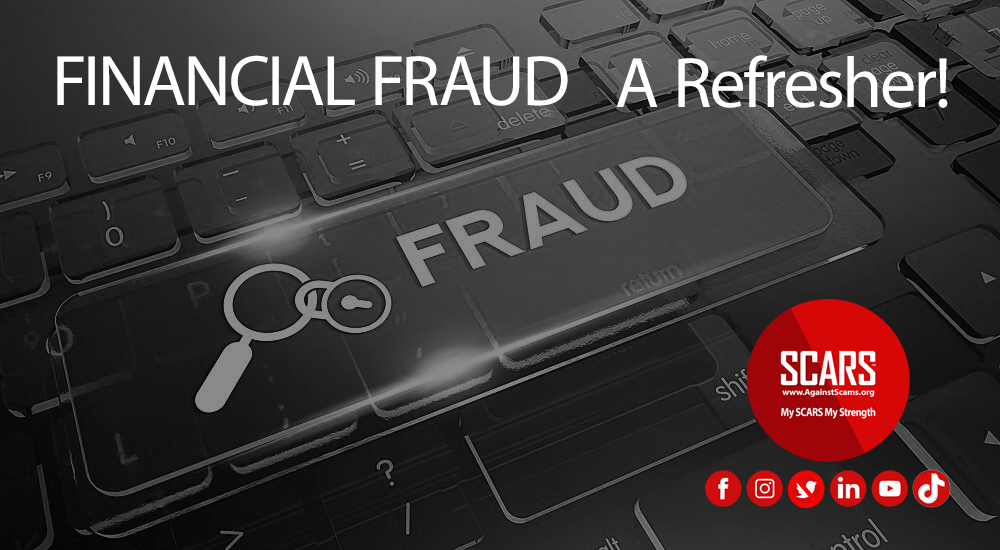Scam Basics: Understanding Synthetic Identity Fraud
A Type Of Identity Theft
Synthetic Identity Fraud is a type of financial crime in which a criminal (or group of criminals) creates a false identity by combining both real and fabricated information to obtain credit, loans, or other financial products. This crime has been on the rise in recent years, and it poses a significant threat to financial institutions, consumers, and businesses. In this article, we will explore how Synthetic Identity Fraud works, who is behind it, how to detect and investigate it, and how to avoid it.
How Does Synthetic Identity Fraud Work?
Synthetic Identity Fraud is a complex and sophisticated crime that involves the creation of a fictitious identity that can be used to apply for credit or other financial products. The criminals behind this fraud usually combine real and fabricated information to create a new identity that can be used to obtain credit. They may use a real social security number, for example, but combine it with a fake name and address.
Once they have created a synthetic identity, the criminals then use it to open bank accounts or apply for credit cards, loans, or other financial products. They may use these accounts to establish a credit history for the synthetic identity, which they can then use to obtain larger loans or credit lines.
The criminals behind Synthetic Identity Fraud can be individuals or organized crime groups that are well-versed in financial fraud. They often use sophisticated techniques, such as creating multiple synthetic identities, to avoid detection.
Who Are The Typical Criminals Behind Synthetic Identity Fraud?
The criminals behind Synthetic Identity Fraud can be anyone from individuals to organized crime groups. However, they tend to be individuals with a background in financial fraud or organized crime groups that specialize in this type of crime.
Individuals involved in Synthetic Identity Fraud may include those with poor credit scores or a criminal history that makes it difficult for them to obtain credit. They may also include those who are trying to evade creditors or financial institutions. However, most often they are professional cybercriminals in it for the potential financial rewards.
Organized crime groups involved in Synthetic Identity Fraud are often highly sophisticated and organized. They may have access to large amounts of personal information, including social security numbers and other identifying information. They can buy the information that originated from major data breaches on the dark web, or obtain enough information from harvesting data from people’s social media profiles.
They may also have the resources to create multiple synthetic identities and establish credit histories for each one.
How To Detect And Investigate Synthetic Identity Fraud?
Detecting and investigating Synthetic Identity Fraud can be challenging, as the criminals behind this type of fraud are often skilled at covering their tracks. However, there are several methods that can be used to detect and investigate this type of fraud.
One of the most effective methods for detecting Synthetic Identity Fraud is to use data analytics and machine learning algorithms to identify patterns and anomalies in credit applications and transactions. These algorithms can help identify suspicious activity, such as the use of multiple identities or the sudden appearance of a large number of new accounts.
Another method for detecting Synthetic Identity Fraud is to use identity verification tools to verify the identity of individuals applying for credit or other financial products. These tools can help verify that the identity being used is legitimate and reduce the risk of fraud.
Once Synthetic Identity Fraud has been detected, it can be investigated using traditional forensic techniques, such as analyzing financial records and conducting interviews with individuals involved in the fraud. Law enforcement agencies may also work with financial institutions to track down the individuals behind the fraud and bring them to justice.
How To Avoid Synthetic Identity Fraud?
There are several steps that individuals and businesses can take to avoid becoming victims of Synthetic Identity Fraud.
Individuals can protect themselves by monitoring their credit reports regularly and reporting any suspicious activity to credit reporting agencies. They can also protect their personal information by using strong passwords, avoiding sharing personal information online and being cautious about providing personal information over the phone or through email.
Businesses can protect themselves by using identity verification tools and conducting thorough background checks on individuals applying for credit or other financial products. They can also implement robust fraud detection and prevention systems that use data analytics and machine learning algorithms to identify suspicious activity.
Synthetic Identity Fraud is a growing problem that can cause significant financial damage to individuals and businesses. It occurs when criminals use a combination of real and fake information to create a new identity that they can use to apply for credit or other financial products. To avoid becoming a victim of Synthetic Identity Fraud, individuals and businesses need to take proactive steps to protect their personal information and implement robust fraud prevention measures.
Here are some tips on how to avoid Synthetic Identity Fraud:
1. Protect your personal information
One of the most important steps you can take to avoid Synthetic Identity Fraud is to protect your personal information. This includes your social security number, date of birth, and other identifying information. Never share this information online or over the phone unless you are certain that you are dealing with a reputable organization.
2. Monitor your credit report
Regularly monitoring your credit report can help you identify any suspicious activity that could indicate Synthetic Identity Fraud. You can obtain a free copy of your credit report from each of the three major credit bureaus (Equifax, Experian, and TransUnion) once a year. Review your report carefully for any errors or fraudulent activity.
3. Use strong passwords
Using strong passwords can help prevent criminals from gaining access to your online accounts and stealing your personal information. Use a combination of upper and lowercase letters, numbers, and symbols to create a password that is difficult to guess.
4. Be cautious about providing personal information
Be cautious when providing personal information online, over the phone, or through email. Only provide personal information to reputable organizations that you trust. If you receive a phone call or email asking for personal information, verify the legitimacy of the request before providing any information.
5. Implement identity verification tools
Businesses can implement identity verification tools to help prevent Synthetic Identity Fraud. These tools can verify the identity of individuals applying for credit or other financial products, reducing the risk of fraud.
6. Conduct thorough background checks
Businesses should conduct thorough background checks on individuals applying for credit or other financial products. This can help identify any red flags that could indicate Synthetic Identity Fraud, such as a history of financial fraud or a criminal record.
7. Implement fraud detection and prevention systems
Implementing fraud detection and prevention systems can help businesses identify suspicious activity and prevent Synthetic Identity Fraud. These systems can use data analytics and machine learning algorithms to identify patterns and anomalies that could indicate fraud.
Essentially, Synthetic Identity Fraud is a serious problem that can cause significant financial damage to individuals and businesses. However, by taking proactive steps to protect your personal information and implementing robust fraud prevention measures, you can significantly reduce the risk of becoming a victim of this type of fraud. Regularly monitoring your credit report, using strong passwords, being cautious about providing personal information, and implementing identity verification tools and fraud detection and prevention systems are all effective strategies for avoiding Synthetic Identity Fraud.
More About Synthetic Identity Fraud
-/ 30 /-
What do you think about this?
Please share your thoughts in a comment below!
Article Rating
Table of Contents
- Learning The Basics Of Online Scams
- Scam Basics: Understanding Synthetic Identity Fraud
- A Type Of Identity Theft
- How Does Synthetic Identity Fraud Work?
- Who Are The Typical Criminals Behind Synthetic Identity Fraud?
- How To Detect And Investigate Synthetic Identity Fraud?
- How To Avoid Synthetic Identity Fraud?
- More About Synthetic Identity Fraud
RATE THIS ARTICLE?
LEAVE A COMMENT?
Recent Comments
On Other Articles
- Nikolaus on Dating Scammers Paradise: Ivory Coast: “The Ivory Coast romance scam is still going on. It seems that local authorities don’t handle the issue effectively!” Dec 10, 02:17
- on The SCARS Institute Top 50 Celebrity Impersonation Scams – 2025: “Thank you – we will.” Dec 7, 11:41
- on The SCARS Institute Top 50 Celebrity Impersonation Scams – 2025: “You should add Sean Bean to your list of Celebrities. This one is very good, and persistent. He will be…” Dec 2, 12:07
- on How You Think & Talk About Your Scam Affects Your Recovery: “I have hung on to the scams for far too long. With the intervention of an all-merciful God, I have…” Nov 6, 22:13
- on Disengaging From A Fake Scam Relationship: “Taci, you may want to join our new support community at www.SCARScommunity.org” Nov 6, 03:01
- on Disengaging From A Fake Scam Relationship: “This particular article helped me discover the many things I did wrong the first time I was scammed. I should…” Nov 5, 22:49
- on About the SCARS RomanceScamsNOW.com Website – 24 Years Published: “It was unavailable for a few days, but it is available again. If he would be interested, he is welcome…” Nov 5, 00:59
- on About the SCARS RomanceScamsNOW.com Website – 24 Years Published: “My husband has been scammed and your classes have been helping him but now he can’t seem to access them.…” Oct 26, 14:57
- on Talia Shepard – Impersonation Victim – Stolen Photos – 2024: “Hi, I’m Patrick from Belgium and I found this site by chance, so I just got to know it, and…” Oct 17, 23:46
- on Talia Shepard – Impersonation Victim – Stolen Photos – 2024: “Hallo ik ben Patrick uit Belgie en het is in verband over PayPal. Ik heb het dit jaar spijtig genoeg…” Oct 17, 23:08
ARTICLE META
Important Information for New Scam Victims
- Please visit www.ScamVictimsSupport.org – a SCARS Website for New Scam Victims & Sextortion Victims
- Enroll in FREE SCARS Scam Survivor’s School now at www.SCARSeducation.org
- Please visit www.ScamPsychology.org – to more fully understand the psychological concepts involved in scams and scam victim recovery
If you are looking for local trauma counselors please visit counseling.AgainstScams.org or join SCARS for our counseling/therapy benefit: membership.AgainstScams.org
If you need to speak with someone now, you can dial 988 or find phone numbers for crisis hotlines all around the world here: www.opencounseling.com/suicide-hotlines
A Note About Labeling!
We often use the term ‘scam victim’ in our articles, but this is a convenience to help those searching for information in search engines like Google. It is just a convenience and has no deeper meaning. If you have come through such an experience, YOU are a Survivor! It was not your fault. You are not alone! Axios!
A Question of Trust
At the SCARS Institute, we invite you to do your own research on the topics we speak about and publish, Our team investigates the subject being discussed, especially when it comes to understanding the scam victims-survivors experience. You can do Google searches but in many cases, you will have to wade through scientific papers and studies. However, remember that biases and perspectives matter and influence the outcome. Regardless, we encourage you to explore these topics as thoroughly as you can for your own awareness.
Statement About Victim Blaming
Some of our articles discuss various aspects of victims. This is both about better understanding victims (the science of victimology) and their behaviors and psychology. This helps us to educate victims/survivors about why these crimes happened and to not blame themselves, better develop recovery programs, and to help victims avoid scams in the future. At times this may sound like blaming the victim, but it does not blame scam victims, we are simply explaining the hows and whys of the experience victims have.
These articles, about the Psychology of Scams or Victim Psychology – meaning that all humans have psychological or cognitive characteristics in common that can either be exploited or work against us – help us all to understand the unique challenges victims face before, during, and after scams, fraud, or cybercrimes. These sometimes talk about some of the vulnerabilities the scammers exploit. Victims rarely have control of them or are even aware of them, until something like a scam happens and then they can learn how their mind works and how to overcome these mechanisms.
Articles like these help victims and others understand these processes and how to help prevent them from being exploited again or to help them recover more easily by understanding their post-scam behaviors. Learn more about the Psychology of Scams at www.ScamPsychology.org
Psychology Disclaimer:
All articles about psychology and the human brain on this website are for information & education only
The information provided in this article is intended for educational and self-help purposes only and should not be construed as a substitute for professional therapy or counseling.
While any self-help techniques outlined herein may be beneficial for scam victims seeking to recover from their experience and move towards recovery, it is important to consult with a qualified mental health professional before initiating any course of action. Each individual’s experience and needs are unique, and what works for one person may not be suitable for another.
Additionally, any approach may not be appropriate for individuals with certain pre-existing mental health conditions or trauma histories. It is advisable to seek guidance from a licensed therapist or counselor who can provide personalized support, guidance, and treatment tailored to your specific needs.
If you are experiencing significant distress or emotional difficulties related to a scam or other traumatic event, please consult your doctor or mental health provider for appropriate care and support.
Also read our SCARS Institute Statement about Professional Care for Scam Victims – click here to go to our ScamsNOW.com website.



















Thank you for your comment. You may receive an email to follow up. We never share your data with marketers.